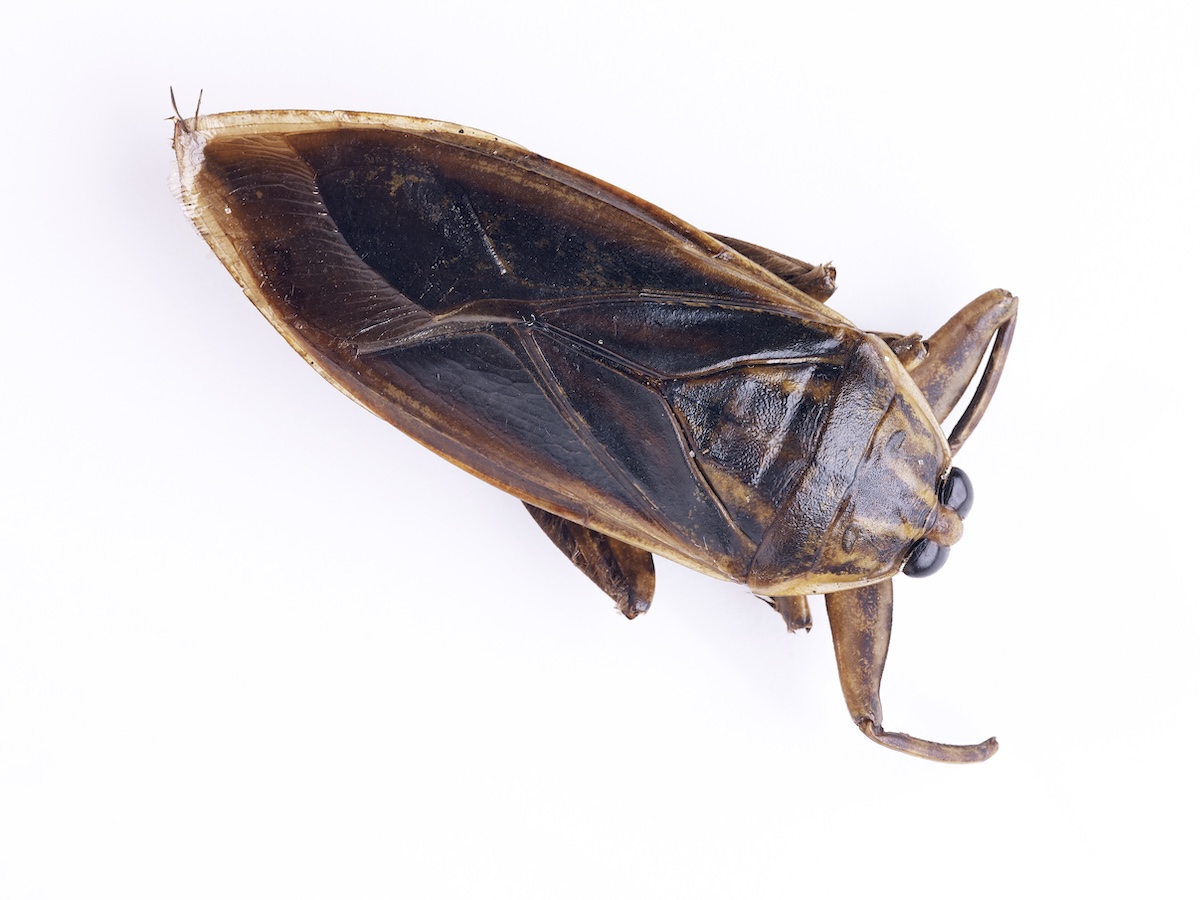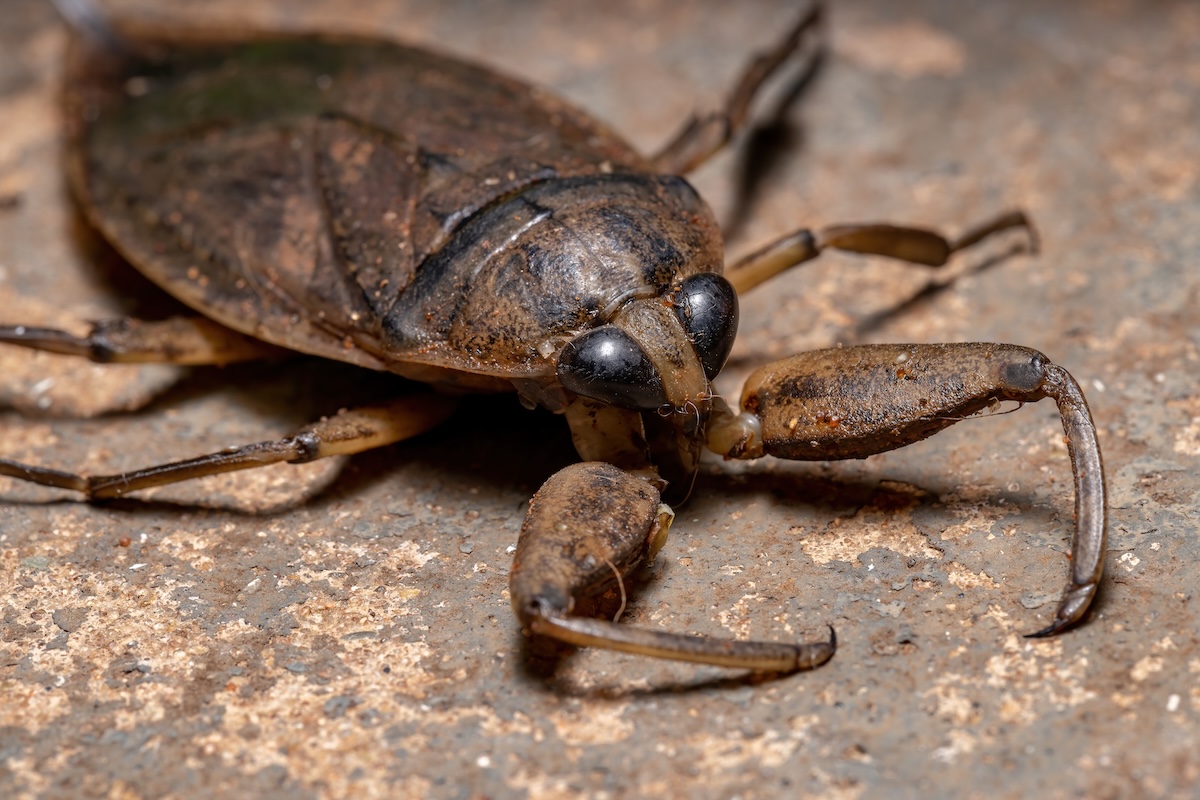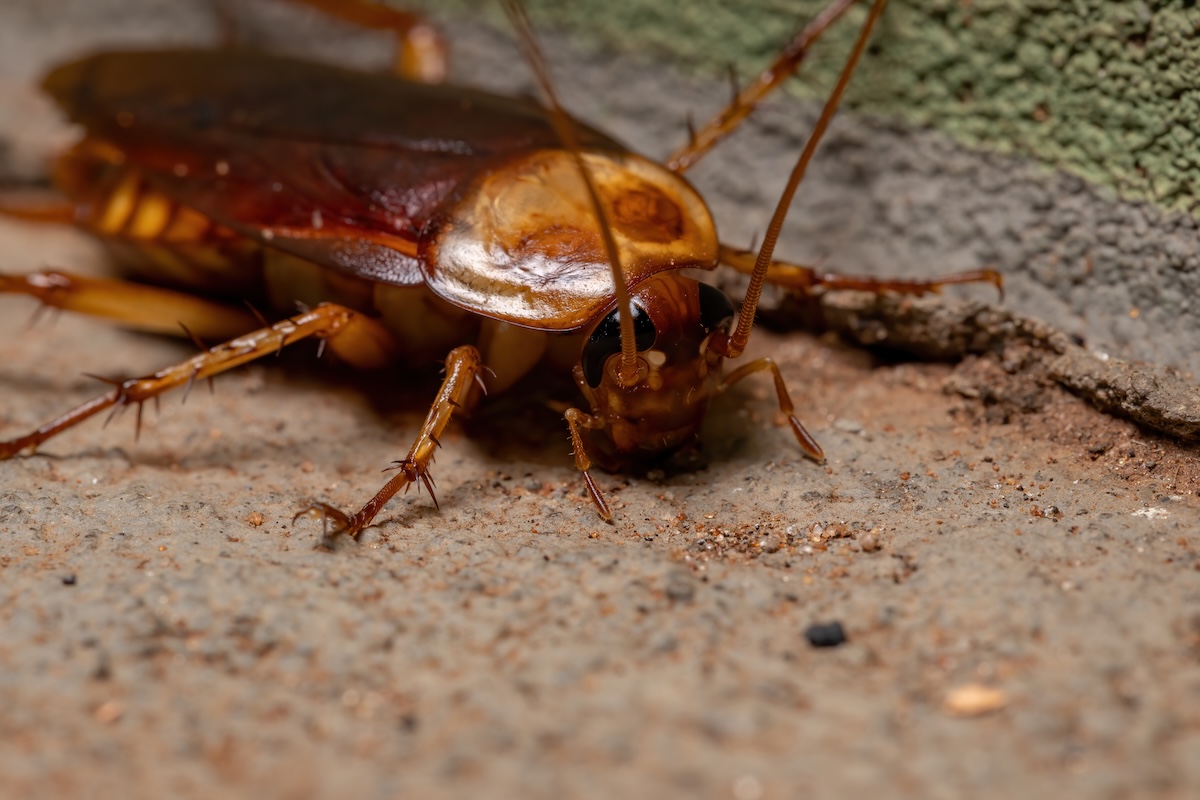

We may earn revenue from the products available on this page and participate in affiliate programs. Learn More ›
When people say they’ve spotted a “water bug” in the house, they’re usually talking about a type of cockroach—often the American or German variety. While water bugs and cockroaches are technically different insects, the terms often are used interchangeably, especially in warmer, humid regions where these pests thrive.
Whichever species you might be talking about, nobody wants these unwelcome visitors hanging around. The good news? With a few strategic changes and some effective DIY methods, it’s possible to eliminate water bugs and prevent them from coming back.
What are water bugs?
True water bugs (Lethocerus sp.) are aquatic insects that belong to the order Hemiptera. Unlike roaches, water bugs spend most of their lives in or near water and rarely show up inside homes unless they’re carried in by accident.
Water bugs are carnivores, using a needle-like beak to pierce and feed on other insects, tadpoles, and small fish. Some species, like the giant water bug (sometimes called a “toe-biter”), can grow up to 4 inches long and are known for delivering a painful bite when threatened.
These insects typically lay eggs on aquatic vegetation or, in some species, on the backs of males who guard them until hatching. They most commonly live in still or slow-moving freshwater environments across a wide distribution of North America, particularly in warmer, humid climates.
What do water bugs look like?
Though they really do look a lot like cockroaches, true water bugs have broad, flat bodies, ranging from 1 to 4 inches long, depending on the species. They are usually dark brown or black and have well-developed front legs for grabbing prey, as well as oar-like hind legs that help them swim. Their wings fold flat across their backs, and many adult types can fly short distances.
Are water bugs the same as roaches?


No, actual water bugs and cockroaches are different insects from different orders. True water bugs are part of the order Hemiptera, while cockroaches belong to the order Blattodea. Confusion often occurs between the two insect types because some cockroach species, like the American cockroach, are colloquially referred to as “water bugs” (since they prefer moist environments).
Here is a comparison:
| Characteristic | Water Bugs | Cockroaches |
| Where they live | Water | Land (moist areas) |
| How they eat | Hunting | Scavenging |
| Physical traits | Short antennae, oar-like legs | Long antennae, spiny legs |
| Found indoors? | Rarely | Commonly |
| Do they bite? | Yes, if threatened | No, but carry bacteria |
Ways to Get Rid of Water Bugs
How to get rid of water bugs can be simple with several effective DIY solutions that use household products. Determining how to kill water bugs reveals some methods that work with types of cockroaches as well. Though you might need to call in the pros for severe infestations, these at-home methods can help manage or even eliminate minor problems before they get worse.
Baking Soda
Baking soda is a simple, low-toxicity home remedy that can be used to combat water bugs. When combined with a sugary bait, such as granulated sugar or peanut butter, baking soda can lure waterbugs in. After ingesting the mixture, the baking soda reacts with the acid in their digestive system, producing gas that they can’t expel (which kills them). This method takes a little time do its work, though, so you may not see results immediately.
To use:
- Mix equal parts baking soda and sugar.
- Place small amounts in shallow dishes or lids and leave them near known bug pathways (under the sink, behind the fridge, or near drains).
- Refresh every few days for best results.
Boric Acid
Boric acid is a time-tested pest control powder that dehydrates and kills water bugs instantly (upon contact or ingestion). It’s especially effective when combined with bait and placed in high-traffic areas for water insects.
To use:
- Lightly dust some boric acid near water bug or cockroach entry points and common hiding places.
- Avoid using too much. If the powder is visible, insects might avoid it completely.
- Keep the powder away from pets and children, as it can be toxic if ingested in large quantities.
Synthetic Chemical Treatments
Synthetic chemical treatments are a common choice for fast-acting, targeted relief from water bugs. These products typically contain active ingredients that disrupt the insect’s nervous system, quickly killing roaches and other pests on contact or shortly after ingestion.
Because these chemicals can be harmful to humans and pets, it’s essential to read all labels carefully and follow safety instructions closely when using them to get rid of water bugs in the house.
These are the most common chemical treatments available:
- Gels like Combat Max Roach Killing Gel, thanks to their syringe-like application method, make it much easier to get pesticide into hard-to-reach places—under the fridge, say, or under the oven.
- Sprays are perhaps the most commonly used type of roach killer used by homeowners for a DIY pest-free home. SC Johnson, the maker of Raid Ant & Roach Killer Spray recommends sending pets and kids outside or otherwise away from the application area and sealing the space for at least 15 minutes before thoroughly airing it out.
Traps
Sticky traps for water bugs usually are available from hardware or garden retailers. The classic Black Flag Roach Motel, for example, can lure and kill roaches out of sight.
According to the University of California’s Statewide Integrated Pest Management Program, putting out traps can help homeowners monitor the extent of their water bug infestation:
- Place traps wherever you’ve seen signs of bugs.
- Check the traps at least once per day, replacing them as needed.
- Keep a record of where traps are catching water bugs and how often
- Use the record to study cockroach activity and whether the problem is improving to aid in future prevention.
Professional Pest Control
DIY methods can go a long way, but sometimes water bugs are too persistent to deal with alone. These pests multiply quickly, and can either bite or carry bacteria, which makes them more than just a nuisance.
“If you haven’t seen any sort of improvement from DIY methods in the first week or two, I would call a professional,” says Matt Smith, owner of Green Pest Management in Wilmington, Delaware. “The longer they have been established, the harder it is to get them out,” he says.
Pest control companies like Orkin or Terminix have the tools and training to identify entry points, eliminate infestations, and help prevent future issues. If the problem is recurring or you’d rather not handle it yourself, calling in a pro can be the most effective (and stress-free) solution.
How to Prevent a Water Bug Infestation
Even after you get rid of water bugs around or in your home, it’s important to take preventive steps to keep water bugs away. Prevention is all about cutting off their access to shelter, moisture, and food. These next steps can help you stop an infestation before it even starts.
Identify entry points and find nests.
The first step in prevention is to figure out where water bugs and roaches are coming from. Inspect dark, damp areas like basements, bathrooms, and under sinks for signs of activity, including live bugs, droppings, or egg cases. If you discover nests, remove them completely and clean the surrounding area with a disinfectant or degreaser.
Once you clear out nests, focus on finding how the bugs might be getting inside. Common entry points include foundation cracks, utility openings, door gaps, and torn window screens.
Seal cracks and gaps in the home’s exterior.

After you find the potential access points, your goal is to seal them to prevent future infestations. Use exterior-grade caulk or weatherproof sealant to close small cracks and gaps. Expanding foam or steel wool can help block larger openings (especially around pipes or vents).
Other helpful strategies include:
- Installing door sweeps on all exterior doors
- Storing garbage bins away from the home
- Trimming back shrubs and vegetation near the foundation
- Putting down gravel around the perimeter of the house
Taking the time to seal up your home can drastically reduce the chance of another water bug problem—especially in humid climates where these pests thrive.
Repair water leaks.
Water tops the list of what attracts water bugs, including cockroaches, so it makes sense that removing water sources around the home where possible can discourage them from invading. Homeowners will want to fix leaky interior and exterior faucets and repair basement walls where water is seeping in. It’s also important to deal with any humidity issues within the home by purchasing a dehumidifier, running exhaust fans, or turning up the air conditioning when it feels humid inside. Dealing with excess water and humidity will guard against water bug infestations, make your home less attractive to other pests, and protect against water damage.
Carefully seal food and trash bins.
Water bugs are scavengers that will eat almost anything, so keeping food properly stored is one of the most effective ways to keep them away. Use airtight containers for pantry items and pet food, and avoid leaving food out overnight.
Trash and recycling bins should have tight-fitting lids, and it’s best to empty them regularly. Whenever possible, rinse recyclables before placing them in the bin to get rid of tempting odors.
Regularly clean and vacuum your home.

Even small crumbs and spills can attract cockroaches. Keep meals to a specific area of the home to minimize messes, and get into the habit of wiping down surfaces and vacuuming floors regularly, especially in high-traffic areas like the kitchen and dining room.
Don’t forget less obvious spots: clean under appliances, around baseboards, and behind trash bins. Deep-clean rugs and carpets at least once a year using a steam cleaner to eliminate lingering food particles and allergens.
Use natural repellents.
Some homeowners prefer a chemical-free approach to pest control, and natural repellents can offer added protection. “Some of the most common natural repellents for water bugs are rosemary and lavender,” says Smith.
Try placing sachets of dried herbs in areas where water bugs might enter, or use essential oils diluted with water as a surface spray near windows, doors, and baseboards. While not a standalone solution, these scents can help deter insects when used alongside other preventive methods.
FAQs
Water bugs and cockroaches are drawn to moisture, food scraps, and dark hiding places. Leaky pipes, standing water, and exposed trash or pet food are common culprits. They also seek shelter in cluttered or damp environments.
Try a mix of boric acid with powdered sugar. The water bugs will eat the sugar and the boric acid will kill them. Pair this with our prevention steps mentioned above, and make sure to seal entry points into your home.
If you live near wet areas where water bugs thrive naturally, it’ll be tough to keep them away forever. But, if you make your home an undesirable place for water bugs to live, they will look for better places to go. Effective prevention methods and regular cleaning are among the best ways to make sure water bugs leave you, and your home, alone.
The water bug lifespan is typically about 1 year. This can be slightly longer depending on the species and the environment.
